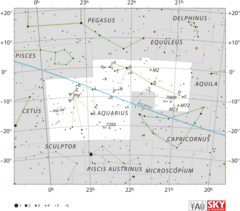Astronomy:Upsilon Aquarii
| Observation data Equinox J2000.0]] (ICRS) | |
|---|---|
| Constellation | Aquarius |
| Right ascension | 22h 34m 41.63670s[1] |
| Declination | –20° 42′ 29.5745″[1] |
| Apparent magnitude (V) | +5.21[2] |
| Characteristics | |
| Spectral type | F7 V[3] |
| B−V color index | +0.44[2] |
| Astrometry | |
| Radial velocity (Rv) | −2.28±0.51[1] km/s |
| Proper motion (μ) | RA: +220.383[1] mas/yr Dec.: –147.225[1] mas/yr |
| Parallax (π) | 43.5816 ± 0.1436[1] mas |
| Distance | 74.8 ± 0.2 ly (22.95 ± 0.08 pc) |
| Absolute magnitude (MV) | +3.44[4] |
| Details | |
| A | |
| Mass | 1.4[5] M☉ |
| Radius | 1.49+0.04 −0.06[1] R☉ |
| Luminosity | 3.581±0.17[1] L☉ |
| Surface gravity (log g) | 4.11[6] cgs |
| Temperature | 6,514±118[1] K |
| Metallicity [Fe/H] | 0.08[5] dex |
| Rotational velocity (v sin i) | 34.9[7] km/s |
| Age | 900 Ma[4] 250+750 −50[5] Myr |
| Other designations | |
| Database references | |
| SIMBAD | data |
Upsilon Aquarii, Latinized from υ Aquarii, is the Bayer designation for a binary star[9] system in the equatorial constellation of Aquarius. It is visible to the naked eye as a faint star with an apparent visual magnitude of 5.21.[2] Parallax measurements give a distance estimate of 74.8 light-years (22.9 parsecs) from Earth.[1] This is a high proper-motion star[8] that is drifting closer to the Sun with a radial velocity of –2.3 km/s.[1] It is part of the Hercules-Lyra association.[9]
The primary component is an F-type main sequence star with a stellar classification of F7 V.[3] It is less than a billion[4][5] years old and is spinning with a projected rotational velocity of 35 km/s.[7] The star has 1.4[5] times the mass of the Sun and 1.5[1] times the Sun's radius. It is radiating 3.6[1] times the Sun's luminosity from its photosphere at an effective temperature of 6,597 K,[6] giving it the yellow-white hue of an F-type star.[10]
The star displays an excess of near infrared radiation, suggesting it has a circumstellar disk of dusty debris.[11] This disk has a mean temperature of 75±17 K and is orbiting at an estimated radius of 84±41 astronomical unit|AU.[12] A faint stellar companion was detected in 2007 at the Gemini Observatory, with a separation of 6.09″±0.03″ from the primary.[9] This is equivalent to a physical projected separation of 139 astronomical unit|AU, which yields an estimated orbital period of ~1,330 years.[13] The debris disk is orbiting close to the dynamically unstable region of this system.[12]
References
- ↑ 1.00 1.01 1.02 1.03 1.04 1.05 1.06 1.07 1.08 1.09 1.10 1.11 1.12 Brown, A. G. A. (August 2018). "Gaia Data Release 2: Summary of the contents and survey properties". Astronomy & Astrophysics 616: A1. doi:10.1051/0004-6361/201833051. Bibcode: 2018A&A...616A...1G. Gaia DR2 record for this source at VizieR.
- ↑ 2.0 2.1 2.2 Johnson, H. L. et al. (1966), "UBVRIJKL photometry of the bright stars", Communications of the Lunar and Planetary Laboratory 4 (99): 99, Bibcode: 1966CoLPL...4...99J.
- ↑ 3.0 3.1 Houk, Nancy; Smith-Moore, M. (1978), Michigan catalogue of two-dimensional spectral types for the HD stars, 4, Ann Arbor: Dept. of Astronomy, University of Michigan, Bibcode: 1988mcts.book.....H.
- ↑ 4.0 4.1 4.2 Nordström, B. et al. (May 2004), "The Geneva-Copenhagen survey of the Solar neighbourhood. Ages, metallicities, and kinematic properties of ˜14 000 F and G dwarfs", Astronomy and Astrophysics 418: 989–1019, doi:10.1051/0004-6361:20035959, Bibcode: 2004A&A...418..989N.
- ↑ 5.0 5.1 5.2 5.3 5.4
- ↑ 6.0 6.1 Gray, R. O. et al. (July 2006), "Contributions to the Nearby Stars (NStars) Project: spectroscopy of stars earlier than M0 within 40 pc-The Southern Sample", The Astronomical Journal 132 (1): 161–170, doi:10.1086/504637, Bibcode: 2006AJ....132..161G.
- ↑ 7.0 7.1 Schröder, C.; Reiners, Ansgar; Schmitt, Jürgen H. M. M. (January 2009), "Ca II HK emission in rapidly rotating stars. Evidence for an onset of the solar-type dynamo", Astronomy and Astrophysics 493 (3): 1099–1107, doi:10.1051/0004-6361:200810377, Bibcode: 2009A&A...493.1099S, http://goedoc.uni-goettingen.de/goescholar/bitstream/handle/1/9690/aa10377-08.pdf?sequence=2[yes|permanent dead link|dead link}}]
- ↑ 8.0 8.1 "* ups Aqr". SIMBAD. Centre de données astronomiques de Strasbourg. http://simbad.u-strasbg.fr/simbad/sim-basic?Ident=%2A+ups+Aqr.
- ↑ 9.0 9.1 9.2 Lafrenière, David et al. (2007), "The Gemini Deep Planet Survey", The Astrophysical Journal 670 (2): 1367–1390, doi:10.1086/522826, Bibcode: 2007ApJ...670.1367L.
- ↑ "The Colour of Stars", Australia Telescope, Outreach and Education (Commonwealth Scientific and Industrial Research Organisation), December 21, 2004, http://outreach.atnf.csiro.au/education/senior/astrophysics/photometry_colour.html, retrieved 2012-07-02.
- ↑ Ertel, S. et al. (October 2014), "A near-infrared interferometric survey of debris-disk stars. IV. An unbiased sample of 92 southern stars observed in H band with VLTI/PIONIER", Astronomy & Astrophysics 570: 20, doi:10.1051/0004-6361/201424438, A128, Bibcode: 2014A&A...570A.128E.
- ↑ 12.0 12.1 Yelverton, Ben; Kennedy, Grant M.; Su, Kate Y. L.; Wyatt, Mark C. (2019), "A statistically significant lack of debris discs in medium separation binary systems", Monthly Notices of the Royal Astronomical Society 488 (3): 3588–3606, doi:10.1093/mnras/stz1927, Bibcode: 2019MNRAS.488.3588Y.
- ↑ Rodriguez, David R. et al. (May 2015), "Stellar multiplicity and debris discs: an unbiased sample", Monthly Notices of the Royal Astronomical Society 449 (3): 3160–3170, doi:10.1093/mnras/stv483, Bibcode: 2015MNRAS.449.3160R.
External links
 |


